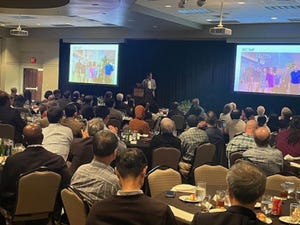Strategies, Considerations to Speed up Clinical Trials
Clinical studies in general are perceived to be time-consuming. Most food supplement and ingredient companies—often the sponsors of clinical studies—consider clinical development gestation periods to be too long to make business sense. Luckily, the clinical trial industry is mature and, as such, has devised methods for speeding human studies for nutraceuticals.

Developing unique claims through own clinical studies is rewarding, but can be painfully slow. In a previous article, a "two-study strategy" is recommended, which, in fact, prolongs the process. But this article offers some suggestions to help offset the time lost by making both studies more time-efficient. Some time-tested approaches, like enrolling participants at multiple sites, are already known. Other strategies contract research organizations (CROs) may use will be discussed.
Clinical studies in general are perceived to be time-consuming. Most food supplement and ingredient companies—often the sponsors of clinical studies—consider clinical development gestation periods to be too long to make business sense; nutraceutical clinical studies can take six to 24 months. Hence, all parties involved must develop strategies to reduce costs and time to do reliable clinical trials. Luckily, the clinical trial industry is mature and, as such, has devised methods for speeding human studies for nutraceuticals.
Preparing for a Study
One of the key reasons clinical trials are perceived as slow has nothing to do with the trial process at all. Experience suggests study preparation, including claim selection and study strategy, requires significant time even before a CRO can begin the study. Some CROs, in the interest of an on-time bid, may not work with the study sponsor closely enough to determine the best clinical strategy for the project. Finalizing a contract on a tentative study outline can mean a protracted discussion after a study is awarded to the CRO, giving the false impression that clinical studies “take a long time.”
Another factor “outside” of the clinical study process is that study sponsors would require at least two clinical studies to conclude with reasonable accuracy whether a supplement works for the proposed health benefit. Sponsors may complain that it took nine months for the first exploratory study and then another 12 months for the conclusive main study. CROs argue that the risks of running a larger conclusive study directly are too large if very little is known about the product. Once the sponsor has reconciled to the overall development plan of two studies and has a clear idea of at least the first exploratory study, should we really start the countdown on the CRO.
A CRO’s ability to cut development costs can be determined by reviewing its bid/proposal, but its ability to cut clinical project duration and minimize or effectively handle delays can be evaluated only with a good personal interview or phone call. The sponsor must directly ask for examples from the CRO that showcase its ability, based on experience, to change tires in a moving car without slowing it down when a clinical trial didn’t go as planned.
Developing & Finalizing Study Protocol
Even after the study outline is agreed and the contract is signed with the CRO, there may be several points of debate that spring up during the study protocol finalization. Such disagreements are unavoidable and, in fact, healthy for the study. After the contract is signed, the CRO will typically appoint and introduce a project manager to steer the study further. The project manager is the central point of contact no matter the stage of the study. It is imperative for sponsors also to appoint a single point of contact for rapid decision-making in this crucial planning phase of the study.
There is increasing interest in offshoring clinical studies to Canada, Eastern Europe and India. Some clinical trial destinations enjoy a natural advantage if the country has kept its food supplement clinical trial regulations simple, whereas other regions may require navigating regulations. For example, in the United States, FDA requires an Investigational New Drug (IND) application in some cases, even if the claim being studied is nutraceutical. It is best to clearly understand the trial approval procedures, normal lead times and risks before selecting a specific country for a study. Some CROs have worked long enough with regulatory agencies and institutional review boards (IRBs) to be able to make convincing presentations of study rationales and secure approvals in the first reviews itself. Check the CRO’s track record prior to study confirmation to avoid such delays.
Think “clinical trials” and most people think “double-blinded, randomized, placebo-controlled trials.” If the role of the placebo is so obvious, why do some sponsors under-appreciate the challenges in making a valid placebo?! If the supplement is not in the form of a capsule or a tablet, more delays in designing and manufacturing the placebo supply can be expected. One company, for example, is facing unusual delays in matching its placebo with its drink formulations. While placebo-matching is likely to be hard, it is better to trigger the process earlier by estimating requirements in advance or having pilot batches made before actual requirements are known. This can sometimes knock off months in the clinical trial process.
Shipping of the suitably-labeled supplement and the placebo can sometimes become the bottleneck. Smart CROs anticipate delays in this step, including overseas shipping, if required, and factor this into planning. Good project managers can expedite protocol development, site preparations, etc., but also ensure that even the processes they don’t actually control (such as placebo-matching and shipping) are also managed efficiently.
The CRO’s prior experience in the particular category, though not a clear determinant of success, does help. However, time to identify and evaluate sites suitable for the protocol can be cut down if the CRO has prior experience in that category.
Recruiting Study Participants
One of the most significant time-saving strategies in a clinical trial requires recruiting and retaining volunteers efficiently. Several approaches have emerged, some of which have been utilized by nutraceutical researchers. Social media is fast emerging as a powerful tool to reach maximum numbers of eligible volunteers, but also has the potential to bring in unqualified people who don’t meet protocol criteria, thus wasting site resources in wasteful screening. Hence, social media advertising must be designed appropriately to be effective. In India, it is common to see notices of camps for free health check-ups to screen populations at risk of diabetes and other metabolic disorders. Fliers at the doctor’s office, labs or pharmacies are common. By far, the two biggest tools to recruitment are qualified databases of study volunteers and multi-centric studies with competitive recruitment. The time savings with these approaches can be as much as three months for an n=100 study. Unfortunately, conducting a study with a university center instead of a CRO often means a single investigator is recruiting for their clinic/lab. Such studies are then subject to the risks of slow recruitment. In contrast, when a CRO faces unforeseen slowdowns at one or more clinics, it will enlist others to speed recruitments.
CROs may rely on multiple other strategies and tactics developed over time to speed study recruitment, build contingency plans and adhere to timelines despite unexpected surprises.
A volunteer dropping out of the study due to non-medical reasons is a disappointing event for project managers. The most common reasons to lose a volunteer from the study are lack of effect, sudden special event like a sickness or other crisis in the family, inability to spare time for follow-up visits, forgetting to take the doses or comply with other protocol conditions, etc. Strategies may be devised to make it easier for volunteers to stay interested in the study apart from the monetary compensation they receive. Many approaches have been tried, such as phlebotomist visits to volunteer homes, home monitoring wearable and sensor devices (e.g., sleep duration and quality, blood pressure, blood sugar, activity levels, heart rate, etc.). Study volunteers may communicate with study personnel remotely via technology (Skype) or use diaries (conventional or on smart phones) to track progress. Volunteers may receive their next supply of supplements in the mail. It is common to use technology-enabled systems to remind volunteers about clinic visits. These approaches are best applied in studies that require multiple visits over more than six months.
The pressures of recruitment and retention can be reduced from the start by reducing the sample size required. Predictive biomarkers, which forecast how a person may respond to a specific nutrient or phytochemical, can help select volunteers most likely to do well in the study, thus reducing sample size.
Adaptive Clinical Trials
Another way to save time and money on trials has emerged in the pharma world, but is not tried as much in nutraceutical trials: adaptive clinical trials. Adaptive clinical trials encourage flexibility and efficiency by allowing for parameters such as treatment regimen, study population and sample size to be modified based on interim results.
Sponsors and CROs alike are facing the challenge of monitoring clinical data on a real time basis for any protocol deviations and violations. Monitoring visit frequencies are typically inadequate to take corrective and preventive actions, thus either compromising data quality or losing volunteers unnecessarily, which, in turn, slows the trial. Clinical trial destinations such as Mumbai, Shanghai or Singapore thrive also because the population densities and efficient public transport allow multiple sites in close proximity, thus making site monitoring and quality control easier and cost feasible. Whether sites are close by or isolated, an efficient electronic data capture (EDC) is the best bet to control data quality. Electronic case report forms (eCRF) can also greatly aid data retrieval from sites and significantly impact data management speeds. Electronic records can be viewed by multiple team members at sites, sponsors and CROs simultaneously, encouraging faster decision-making. eCRFs, however cannot solve other site-related issues that will emerge in any study that need face-to-face interaction between project managers and clinical research associates with the site staff.
Clinical study teams are under tremendous pressure to deliver on time, and some of the suggestions here may be useful. Others may emerge by asking the right questions at the planning stage because each study is different. Researchers must think outside the box and provide timely return on investment (ROI) to investors in clinical trials for foods and supplements.
This article is the third in a series of articles reviewing strategies and considerations around clinical trials. Previous articles include “Understanding Clinical Trials” and “Maximizing Investments in Clinical Research.”
Jayesh Chaudhary is a co-founder and CEO of Vedic Lifesciences, a “verifiable” CRO serving the nutra industry for more than 17 years. He is among the pioneers who brought good clinical practices (GCP) and other stringent standards to natural product research.
About the Author(s)
You May Also Like




.png?width=800&auto=webp&quality=80&disable=upscale)